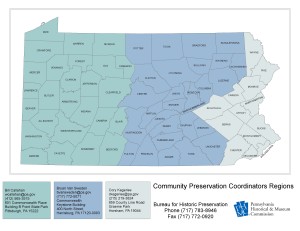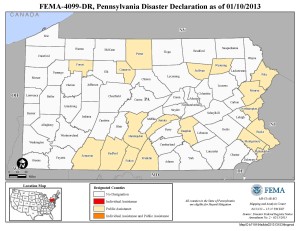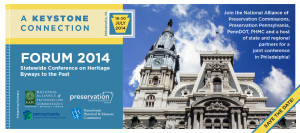In the bill authorizing funds for recovery from Hurricane Sandy, Congress allocated $50 million to the National Park Service (NPS) specifically for projects related to historic properties in the affected states. The majority of these funds were directed to New Jersey, New York, Rhode Island, and Connecticut, while the rest was made available on a competitive basis to other states in the region. The Pennsylvania Historic Preservation Office submitted their request for funding to the NPS in July, and in December the Park Service announced that the Commonwealth had been selected for a $1.5 million grant, the largest amount awarded through the competitive funding process! The staff is now working to finalize the scope of the project and to move forward with the next steps.
The disaster recovery funds were intended to assist property owners with repair and restoration work on their historic buildings that was not covered by private insurance or the Federal Emergency Management Agency (FEMA). However the Historic Preservation Office staff has only learned of a few reports of serious damage. (Do you know of a historic property that was damaged by Sandy? Contact the Community Preservation Coordinator for your region.)

Instead, the money Pennsylvania is receiving will be focused on planning for future disasters. The staff hopes to identify and document historic properties and neighborhoods that stand in areas that have repeatedly flooded as a result of tropical storms or heavy rains. By building awareness of the cultural resources in these creek and river valleys, local communities can prioritize projects that are intended to reduce the risk of major flooding or at least anticipate the damage that may occur there. The information collected as part of these survey and planning projects will also help to streamline the Section 106 review process when residents and municipalities must make property repairs in the aftermath of severe storms.
The money must be used for projects in one of the eighteen counties that were declared as federal disaster areas in the wake of Hurricane Sandy. For each of these counties, Historic Preservation Office staff will evaluate the needs for historic resource survey, focusing on those municipalities that are most at risk of future storm damage. After developing a preliminary scope of work for these projects, the staff will request proposals from consultants to conduct the surveys. It is hoped that the first of these projects will begin later this year.
All of this is happening at a time when both the federal and state government are working to help local communities become better prepared for a range of natural and manmade emergencies. At the national level, FEMA has introduced the National Disaster Recovery Framework (NRDF), which seeks to lay the groundwork for improved local disaster response and recovery. Not only does the Framework promote best practices for major repairs and reconstruction following a disaster, but it can also help communities build their capacity for long-term recovery: re-housing residents, retaining local businesses, and encouraging sustainable economic development. Last fall, the PA Department of Community and Economic Development (DCED) announced the Recovery Resources Team, which will be responsible for implementing the national framework in the commonwealth. Both of these initiatives are working to identify partners and strategies for addressing specific disaster recovery needs in six areas, one of which is natural and cultural resources. (The others are economic, infrastructure, community planning and capacity building, housing, and health and social services.)
The preservation community is likewise attempting to build awareness of the need to plan for disasters. In recent years, catastrophic hurricanes such as Hurricanes Katrina and Sandy, as well as river flooding, tornados, earthquakes, and wildfires have damaged or destroyed hundreds of historic buildings, districts, and sites across the country. For that reason, the National Alliance of Preservation Commissions (NAPC) dedicated its November-December 2013 issue of The Alliance Review to articles on disaster planning in historic districts. And this summer NAPC, in partnership with Preservation Pennsylvania and the PHMC, will offer several sessions on this topic at their biannual Forum, combined this year with our own Statewide Conference on Heritage in Philadelphia. Look for the preliminary conference agenda to be published next month.
The arts and cultural community is similarly looking for ways to better protect our shared cultural heritage. At the national level, Heritage Preservation has established the Heritage Emergency National Task Force to help museums, art galleries, libraries, and historical organizations plan for a range of disasters. Among the tools they are using is the Heritage Emergency Partnership blog, which will keep those involved in the statewide networks informed of new developments and best practices in this area.
Here in Pennsylvania, the Conservation Center for Art & Historical Artifacts (CCAHA) in Philadelphia is taking the lead in coordinating disaster assistance and emergency planning efforts with local organizations and institutions across the state. Staff members of the Historic Preservation Office, the State Archives, and the Bureau of Historic Sites and Museums are involved in the early stages of this CCAHA initiative to promote strategies for safeguarding the commonwealth’s treasured art, historical, and archival collections and training local staff and volunteers about what they can do to recover from the damaging effects of water, fire, and wind.
Disasters like Sandy always teach us that our communities can and should be better prepared. So read up on the programs and initiatives going on at the state and national level, connect with your county and local emergency management teams, and contact your regional preservation coordinator to learn more about what the Historic Preservation Office can do to help you plan for floods and other catastrophic events.
Comment Policy
PHMC welcomes and encourages topic-related comments on this blog. PHMC reserves the right to remove comments that in PHMC’s discretion do not follow participation guidelines.
Commenters and Comments shall be related to the blog post topic and respectful of others who use this site.
Commenters and Comments shall not: use language that is offensive, inflammatory or provocative (this includes, but is not limited to, using profanity, obscene, or vulgar comments); disparage other commenters or people; condone illegal activity; identify the location of known or suspected archeological sites; post personal information in comments such as addresses, phone numbers, e-mail addresses or other contact details, which may relate to you or other individuals; impersonate or falsely claim to represent a person or an organization; make any commercial endorsement or promotion of any product, service or publication.
If you would like to comment on other topics not related to this blog post but related to PHMC, please fill out the PHMC Contact Us Form.



Bryan,
Good article. I will follow this initiative and plan to attend the conference. ( there’s always the threat of damage from sprinklers, too)
Carol Hickey